Exercise Falcon Strike 2015: China J11 34 – 42 Thai Gripen | Full Translated Report
According to a report by Alert5 that is published on 10 December 2019, which somehow gone viral recently after National Interest wrote an article based on the report. So we decided to join in the fun, but report directly based on the “leaked photos” of the after action review presentation in the Alert5 report.
We will translate everything that is in the presentation, word for word – so you can make you own assessment.
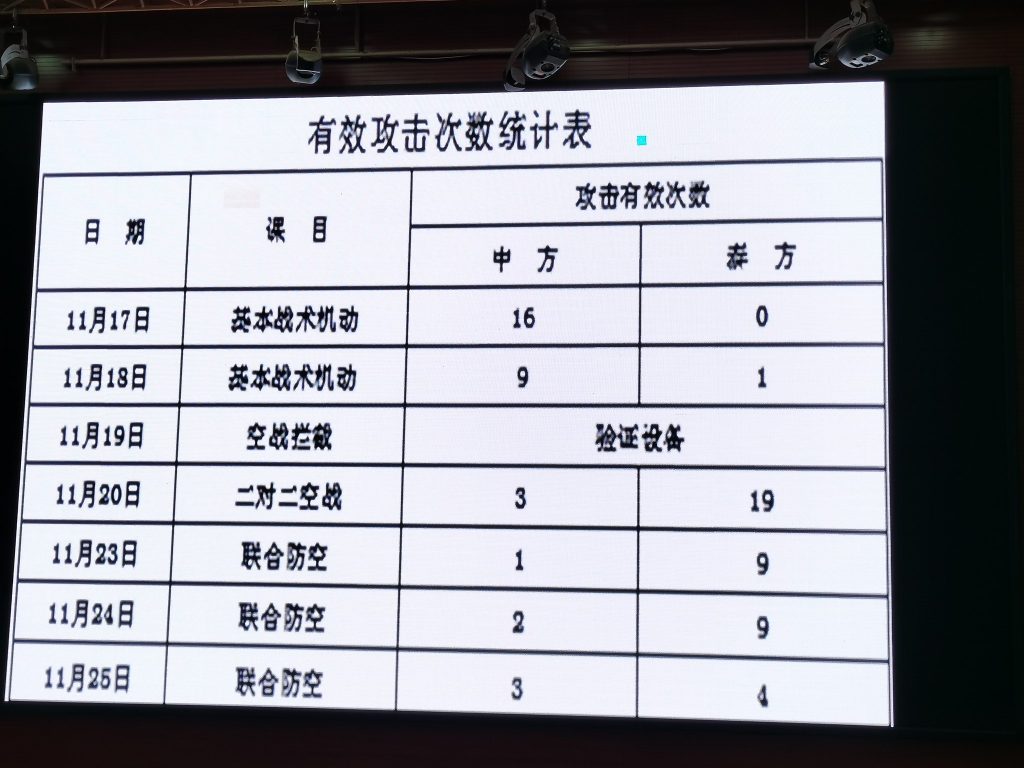
有效攻击次数统计表 = Total Effective Attack Counts/Table
First Row: 日期 Date, 课目 Subject, 有效攻击次数 Effective Attack Counts ( left: 中方 China side | right: 泰方 Thai side )
17 Nov
基本战术机动 Basic combat maneuvers
China 16
Thailand 0
18 Nov
基本战术机动 Basic combat maneuvers
China 9
Thailand 1
19 Nov
空战拦截 Aerial Intercept : 验证设备 Equipment Certification
20 Nov
二对二空战 2V2 air battle
China 3
Thailand 19
23 Nov
联合防空 Combined air defense
China 1
Thailand 9
24 Nov
联合防空 Combined air defense
China 2
Thailand 9
25 Nov
联合防空 Combined air defense
China 3
Thailand 4
DPA Notes: It is unlikely that the last 3 days of “combined air defense” would be purely another China vs Thailand sparring between aircraft. It is more likely to be a combined exercise that will improve interoperability.
Thus we might suggest that the reporting by National Interest might be wrong on this part, wrongly attributing the last 3 days of exercise to be another air versus air scenario (which would be a waste of time after 3 days of probably the exact same thing if that’s the case). The error might be attributed to the possible lack of chinese reader in the press room.
In our opinion, the actual air to air score would be based on the first 3 days of aerial exercise:
China: 16 + 9 + 3 = 28
Thailand: 0 + 1 + 19 = 20
which translate to an overwhelming victory for China’s J11 than the Thailand’s Gripen.
However, the worrying thing for the People Liberation Army Air Force, is the lack of ability to fight as a team, despite their superiority in a one on one dogfight situation (which is likely to be short range combat – since the emphasis was “basic combat maneuvers”.
But when the fight goes to 2 on 2, Thailand’s Gripens quickly gained an advantage, possibly because of better communication or tactics by the Thai pilots – and possibly due to the longer distance a 2 v 2 air to air combat exercise would demand. But there is no indication in the slides on all these details, which was so elaborated by the other media reports that was not written in the Alert5 report.
Just for additional note, during the exercise the RTAF fielded five JAS-39C/D Gripen aircraft while China deployed four Su-27SK Flanker B and two J-11A Flanker B aircraft, according to an article by “The rhk111 Military and Arms Page“
Which also mean, that, it is not exactly Gripens vs J-11, but Gripens vs 1/3 of J-11… or more accurately, Gripens vs Flankers.
In our opinion, the actual air to air score would be based on the first 3 days of aerial exercise:
China: 16 + 9 + 3 = 28
Thailand: 0 + 1 + 19 = 20
which translate to an overwhelming victory for China’s J11 than the Thailand’s Gripen.
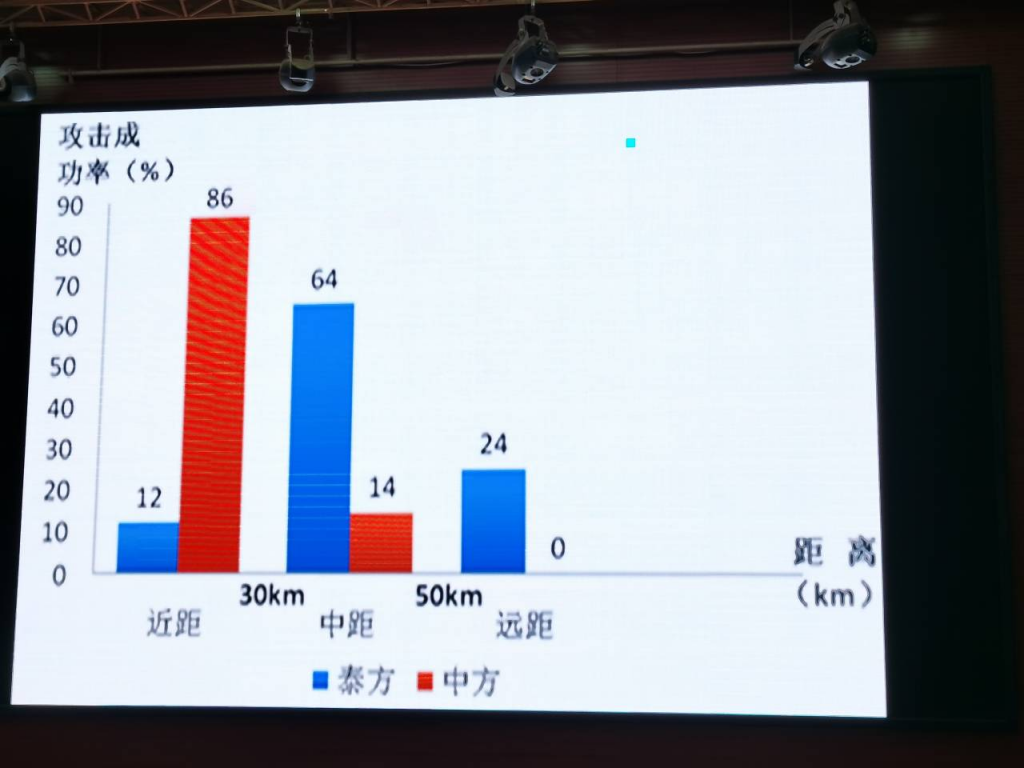
攻击成功率(%) Attack Success Rate (%)
近距 Short Range (0 ~ 30km)
Thailand: 12%
China: 86%
中距 Medium Range (30 ~ 50km)
Thailand: 64%
China: 14%
远距 Long Range (50km and beyond)
Thailand: 24%
China: 0%
距离(km) Distance (km)
Blue : Thailand
Red : China
DPA Notes: Based on this slide, there is no indication that the first 2 days is purely short range dogfights. And if you are sharp, you will find that the percentage does not really fit nicely with the successful attack counts.
We tried a few combination of the numbers, to figure how they get the percentage; but we dont seem to find a way to make it work – so its really up to your interpretation.
But what you need to note is, its a % of the success rate – which means, even for the Gripen, their long range attacks (beyond 50km) have only a 24% success rate (which of course trumps the 0% by the J11 / Flankers). They fair better when the distance closed to between 30~50km, which 64% of the attack succeeded, while J11 / Flankers did an atrocious 14% success rate in their mid distance attacks.
But once within 30km, J11 / Flankers proves to be extremely effective, killing their opponent 86% of the time, while the Gripen struggles at 12% (which is worse than J11 / Flankers’ mid range success rate).
Another thing to note is how fast the 2 jets will close in on each other from a mid range distance into a dogfighting short range distance, which J11 / Flankers excels:
Gripen’s speed: above 2000km/h
J11’s speed: also above 2000km/h
2000km/h = 33.3km/min = 0.555km/second
And if you have 2 of these jets flying straight at each other, they will close the 20km distance (30~50km) in just 18 seconds. And we are not even counting their max possible speed. Thus there is definitely a lot more details we are not seeing that happened during those 2 v 2 fights – but we are quite sure that, the killed Gripens are mostly due to the fact that they accidentally drifted into a dogfighting distance with the J11 / Flankers.
Thus the only effective strategy for Gripens, would be locking their targets beyond visual range / long distance, and only releases their missiles once they get into the sweet zone of 30~50km distance between them and their target – once they fire, immediately turn around and keep their distance from the J11 / Flankers.
Which then we also start to doubt the claim that it is the AIM-120s that are doing the job for Gripen.
The effective range for the shortest range AIM-120 is actually AIM-120A/B: 55–75 km – which is actually considered “long range” in this presentation. Although its conceivable that the missile can still be fired within 50km. AIM-9 operational range is instead between 1.0 to 35.4 km – which MIGHT fit the profile a bit more. (but will never know, since the report did not indicate). Thus we note the amount of assumptions in some articles out there.
In summary, it could be a case where the first 2 days of basic combat maneuvers, on a 1 v 1 situation, the Gripens have no ways to keep a distance (as mentioned by how fast the 2 jets closes the distance), and the Gripens might have fired a number of short range missiles (AIM-9) but almost all of them missed the targets. But in a 2 v 2 situation, Gripens could keep a stand off distance with their team work and proceed to take out the J11 / Flankers by luring them into tactical mistakes (we are guessing), thus allowing the Gripens to outperform the J11 / Flankers in the mid distance (but this is not an indication that the AIM-120 or mid distance missiles are better, its possible because they are able to position themselves in better firing position, thanks to the superior team work)
Which means also, there is no indication that Gripen is actually the better aircraft when compared to the J11.
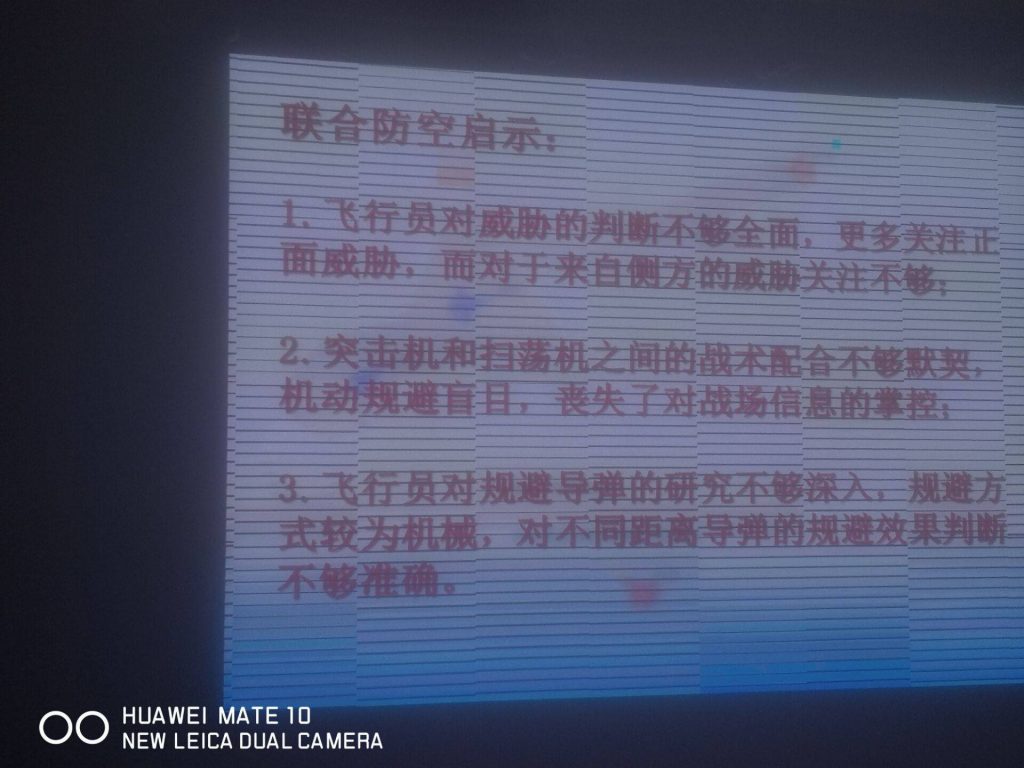
联合防空启示 Combined air defense revelations
- 飞行员对威胁的判断不够全面,更多关注正面威胁,而对于来自侧方的威胁关注不够;
Pilot’s judgement against threats are not complete/comprehensive enough, more attention towards frontal threats, but attention towards threats from the sides isn’t enough; - 突击机和扫荡机之间的战术配合不够默契,机动规避盲目,丧失了对战场信息的掌控;
The tactical cooperation between the assault aircraft and sweeping aircraft is not “tacit understanding” (aka team work or reading each other’s mind) enough, maneuvering and evading/dodging blindly, losing the control of battlefield awareness/information. - 飞行员对规避导弹的研究不够深入,规避方式较为机械,对不同距离导弹的规避效果判断不够准确。
Pilot’s studying/research/understanding of evading missiles are not deep enough (insufficient), evasive methods are more mechanical, evasive effective assessment in relation to missiles of various distances is not accurate enough.
DPA Notes: As you can read from the title of the slide, it reads “combined air defense” – I may understand it wrongly (you can make your own assessments) – it MIGHT not be describing the first three air to air exercise, but instead purely focusing on the final 3 combined air defense exercises – where perhaps they went on missions.
But the assessment isn’t exactly damning as you can see – but its more of review of what should be improved – mainly the need for the pilots to have better situational awareness and not just be focus head long into their frontal targets or the evasive maneuvers. And the most importantly, to understand better on how to dodge missiles.
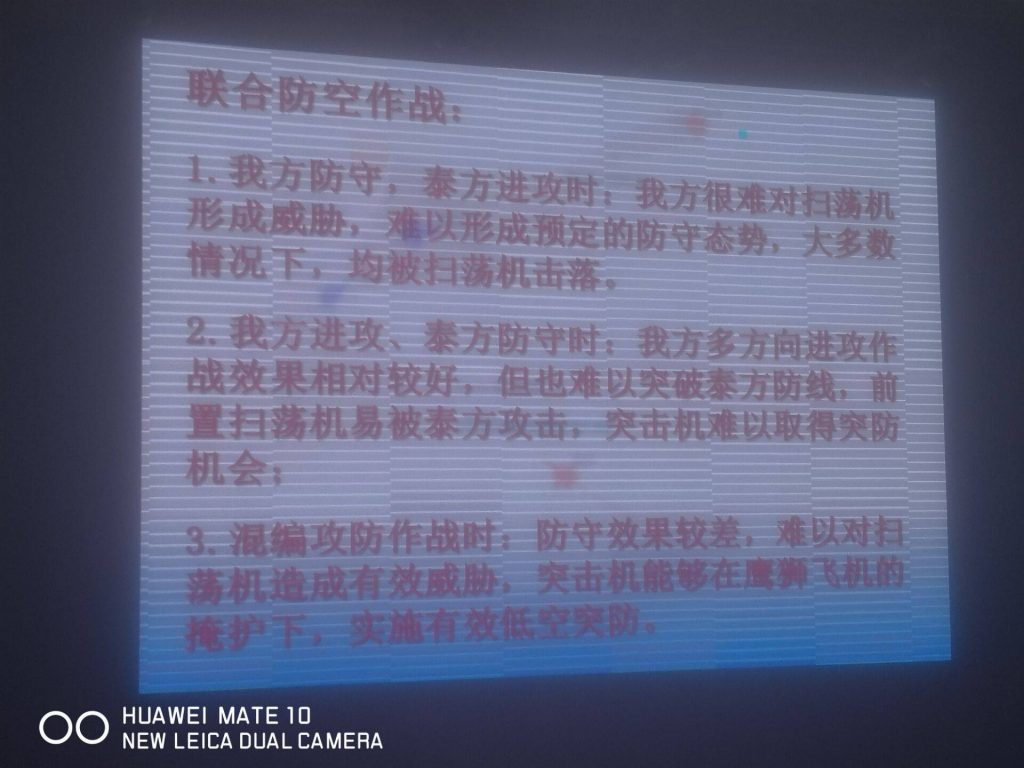
联合防空作战 Combined air defense combat
- 我方防守,泰方进攻时:我方很难对扫荡机形成威胁,难以形成预定的防守态势,大多数情况下,均被扫荡机击落。
Then our side defend, Thai side attack: our side find it very difficult to pose a threat to the “sweeping aircraft”, difficult to form predetermined defensive posture, most of the cases, all are shot down by the sweeping aircraft. - 我方进攻,泰方防守时:我方多方向进攻作战效果相对较好,但也难以突破泰方防线,前置扫荡机易被泰方攻击。突击机难以取得突防机会;
When our side attack, Thai side defend: our multi-directional attacking have better combat effect in comparison, but still hardly able to break the Thai defensive line, point positioned sweeping aircraft easily attacked by the Thai side. Assault aircraft find it difficult to get an opportunity to penetrate; - 混编攻防作战时:防守效果较差,难以对扫荡机造成有效威胁,突击机能够在鹰狮飞机的掩护下,实施有效低空突防。
During mix offensive and defense operations: defensive effective is worse, unable to post an effective threat to sweeping aircraft, assault aircrafts able to perform effective low altitude air defense under the cover of the Gripens.
DPA Notes: I struggled to find the correct definition of 扫荡机 (sweeping/sweeper aircraft) online – I suspect its a military term and it is not used in public domain. We suspect sweeper aircraft to be referring to fighter escorts for assault aircraft/bombers – which we can read it as air superiority fighters.
Anyway, its not exactly clear from just the slide if there are ground elements involved, since “defense” would mean there is something to defense at the first place. Especially when “multi-directional attacking” is mentioned – but of course, I’m merely guessing at this point. Feels a little bewildering reading without full context.=
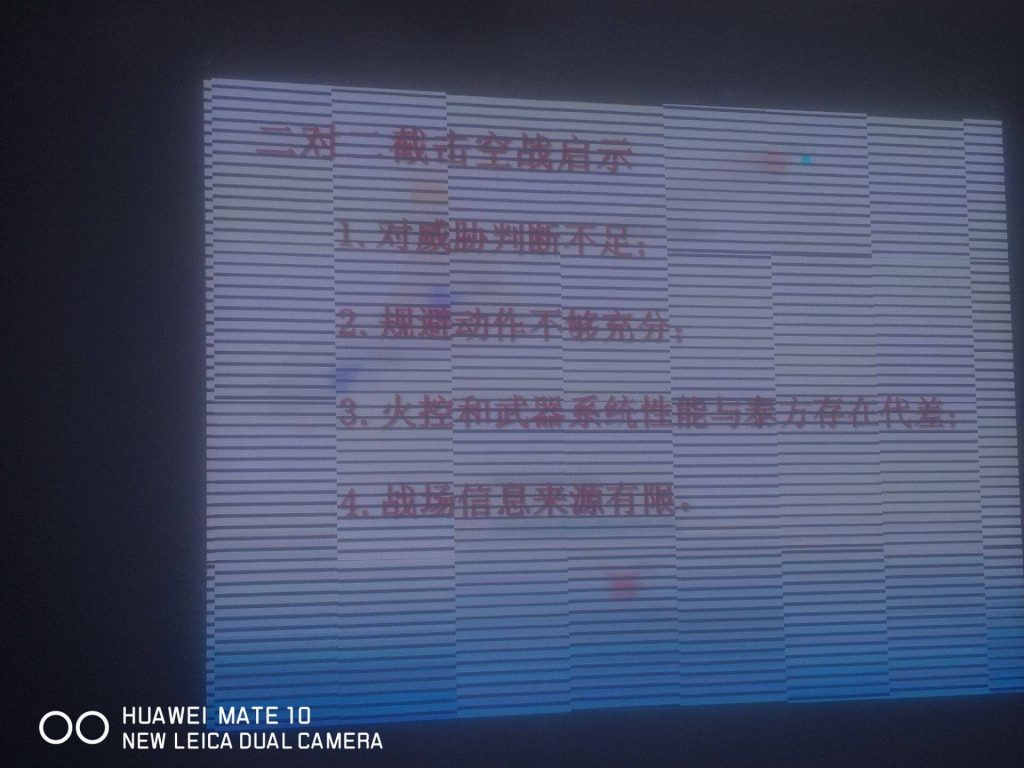
二对二截击空战启示 2v2 Interception air combat revelation
- 对威胁判断不足;
Inadequate threat appreciation/analysis - 规避动作不够充分;
Evasive maneuver insufficient - 火控和武器系统性能与泰方存有代差;
Fire control and weapon system capability possesses generational gap against the Thai side. - 战场信息来源有限。
Battlefield information sources is limited.
DPA Notes: According to AIN online’s report on the same exercise/lecture last year (apparently the screenshots are from the lecture at China’s Northwestern Polytechnical University in Xi’an (西北工业大学), Senior Colonel Li Chunghua (李中華), whom is one of the most heavily decorated pilot in the PLAAF according to AIN online, indicates that the radar crossed section of the Gripens is significantly smaller than the Su-27 ; as a result, they had more trouble detecting the Gripen, contributing to the limited battlefield situational awareness.
The fire control and weapon system generational gap is likely also referring to the ability for Gripen to fire 4 AIM-120 missiles at once, while the J11 / Flankers can only fire one RVV-AE missile at a time.
Although with the heavy advantage on the Thai side due to the technological advantages, I’m not exactly sure how much improvement in threat analysis and evasive actions is going to help them survive these beyond visual range fights.
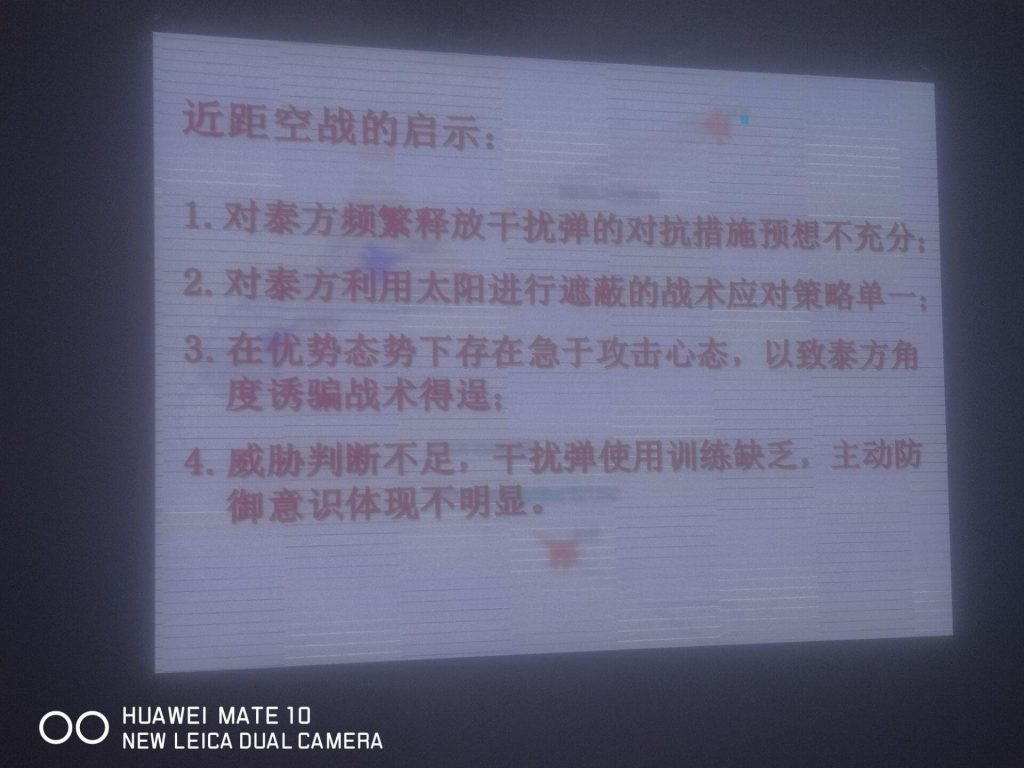
近距空战的启示:Short range air combat revelations:
- 对泰方频繁释放干扰弹的抗措施预想不充分;
Inadequate anticipation of the frequent usage of flares/chaff countermeasures by the Thai side - 对泰方利用太阳进行遮蔽的战术应对策略单一;
Singular strategy when responding to Thai side’s usage of the sun as cover - 在优势姿态下存在急于攻击心态,一致泰方角度诱骗战术得逞;
When the situation/position is advantageous, the urging tendency is to attack, consistently fall victim to the angle deception / luring tactics by the Thai side - 威胁判断不足,干扰弹使用训练缺乏,主动防御意识体现不明显。
Inadequate threat appreciation/judgement, lack of training on flare/chaff countermeasures, assertive defensive awareness/consciousness is not obviously shown.
DPA Notes: So curiously despite the overwhelming “victories” in short range air combat by the Chinese, it seems like they are tactically inferior to the Thais.
Which means, if the Thai side opted to use the Diehl IRIS-T missile in the exercise instead of the AIM-9L sidewinder, the short range air combat statistics might be a lot different.

However, it is good to note that, the Chinese brought really old aircrafts to the sparring sessions and still managed a good account of themselves (and not just get trashed regardless of the range). From the slides, the emphasis is largely on the lack of situational awareness, poor tactics and perhaps poor decision making. I dont think its indicative of anything significant especially both sides did not put in their best machines to give up their operational secrets.
Nevertheless, I would highly recommend a read of the AIN online article below for the additional information mentioned by in the lecture.

